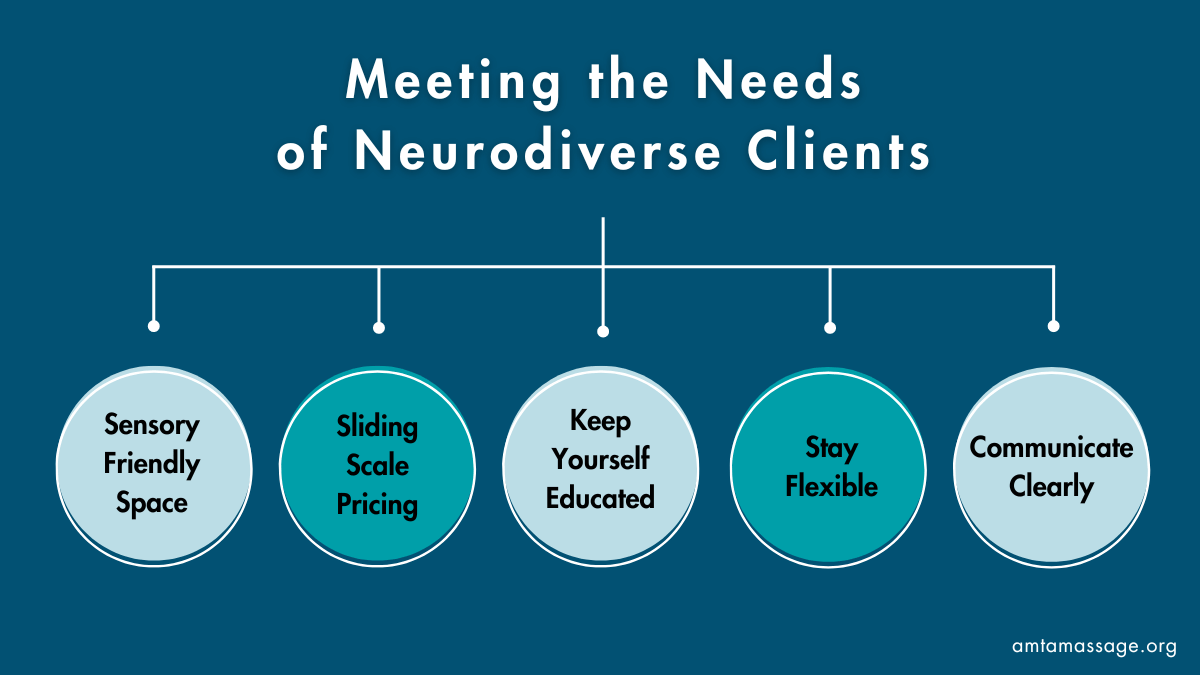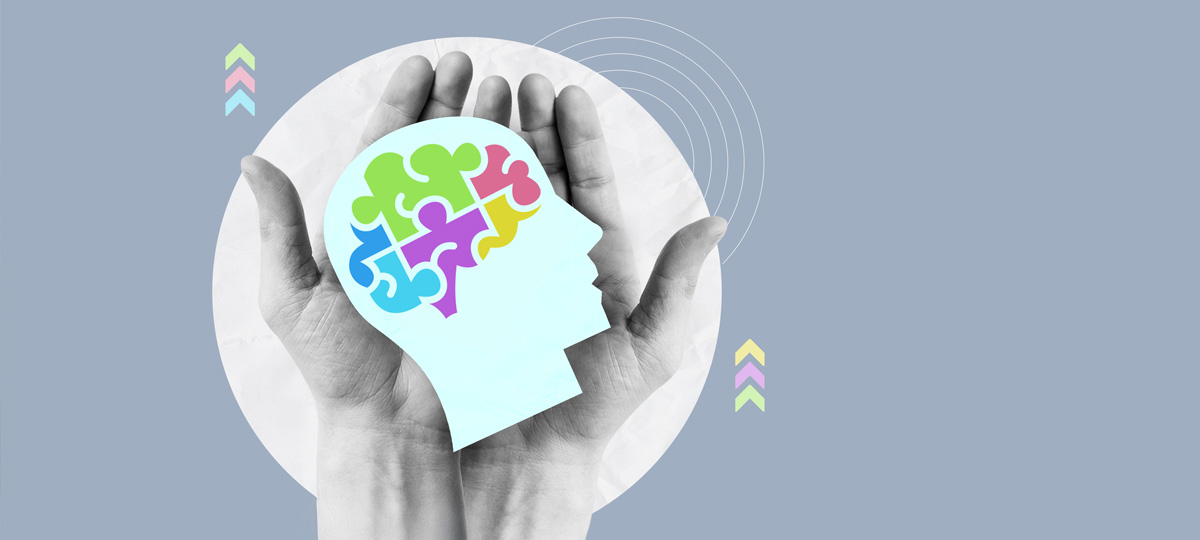What is Neurodiversity?
The Cleveland Clinic describes neurodiversity this way: “Neurodivergent is a nonmedical term that describes people whose brains develop or work differently for some reason. This means the person has different strengths and struggles from people whose brains develop or work more typically.”
But broad and general descriptions should not be mistaken for singular definitions that can be used to encompass every neurodiverse person. “When you know one neurodiverse person, you know one neurodiverse person,” explains Sam Pohl, RMP and co-owner at Metta Integrative Wellness Cooperative, who, as a late-diagnosed autistic person, are themselves neurodiverse. “Everyone is different, and we all have different needs, and those needs can change from session to session.”
Ann Blair Kennedy is the associate professor and director of the Patient Engagement Studio at the University of South Carolina School of Medicine Greenville and a massage therapist with 25 years of experience. Her experience with neurodiversity began young, growing up with an autistic brother and having ADHD herself. Now, she’s raising two neurodiverse kids and describes herself as neurospicy.
Kennedy suggests looking at how other fields address meeting the needs of neurodiverse people as a helpful starting point. “Two that come to mind are universal design in education and trauma informed care in health care,” she notes. “Both of those approaches focus on inclusivity, accessibility and the assumption of diverse needs among individuals. Additionally, both these approaches provide frameworks that are proactive rather than reactive, and both emphasize the importance of creating environments where people feel safe and included.”
Here, you’ll learn about some—not all—of the common conditions that affect neurodiverse people, along with some helpful ways you can make massage therapy more accessible and comfortable for these clients.
Common Conditions You May See in Your Neurodiverse Clients—And How Massage Might Help
Kennedy cautions that massage isn’t likely going to help all neurodivergent clients, but may be a great intervention for some neurodivergent people looking for help addressing some of the sensory, emotional and physical challenges common in some conditions like Autism Spectrum Disorder (ASD), Attention Deficit Hyperactivity Disorder (ADHD), Sensory Processing Disorder (SPD) and Dyspraxia.
Austism Spectrum Disorder (ASD)
For some autistic people, body awareness is challenging. In the simplest terms, body awareness in this context is often referred to as proprioception and describes a person’s sense of where their body is in relation to the immediate space around them. “Massage may improve the sense of where their bodies are in space,” Kennedy suggests, “thereby assisting with coordination and spatial orientation.”
Additionally, many people with ASD have sensory processing issues that include sensitivities around sights, sounds, smells, touch and balance, to name a few. “Massage can provide a regulated sensory experience, which may help reduce hypersensitivities and improve sensory integration,” Kennedy notes.
Pohl accounts for some of these known sensitivities in their practice. “Keeping a scent-free room is the first step to making any massage space sensory-friendly,” they explain. “Giving clients the ability to change the temperature of the table, volume or type of music playing, and making weighted blankets available are all sensory accommodations.”
Pohl explains you probably won’t be able to make everything in your practice customizable, but doing what you can within your own limitations and giving your neurodiverse clients choices when possible is helpful. “Being explicit about the client being able to request changes is also important,” they add.
Attention Deficit Hyperactivity Disorder (ADHD)
Kennedy suggests that the relaxation and stress relief that is a hallmark of massage therapy may prove helpful for people with ADHD who are looking for ways to increase focus and concentration. “By promoting relaxation and reducing hyperactivity, massage therapy can potentially help individuals with ADHD improve their ability to concentrate and focus,” she says.
The same holds true for the sometimes high levels of anxiety experienced by people with ADHD. By lowering anxiety levels, massage may be able to help people improve their emotional regulation.
Some research bolsters these claims. An early systematic review and meta-analysis examining the effects of massage therapy for children and adolescents with ADHD1 showed some positive results, though was small, comprising only eight randomized controlled trials and three case studies for systematic review. A meta-analysis of four of the eight randomized controlled trials was also conducted.
“Pooled analysis showed that massage produced more improvement in ADHD symptoms in terms of effective rate compared to Ritalin,” researchers noted. “Individual randomized controlled trials suggested that massage differed significantly from waitlist control in improving the conditions of anxious-passive and asocial behavior.”
A more recent pilot randomized controlled trial2 explored the effects of parent-administered pediatric tuina massage for ADHD symptoms in preschool children. Tuina is a modality similar to Shiatsu.
Participants were assigned to either a parent-administered tuina group or a parent-child interaction group, where parents were coached on a progressive muscle relaxation exercise. Both interventions were carried out every other day for at least 20 minutes for a two-month intervention period.
Researchers found that both intervention groups showed improvement with moderate within-group effect size. The between-group effect size was minimal. “Perceived improvements on children’s appetite and sleep quality, and parent-child relationship was observed in qualitative data,” researchers noted. “Parent-administered pediatric tuina provided beneficial effects on improving core hyperactivity/impulsivity symptoms in preschool children.”
Sensory Processing Disorder (SPD)
Some of the benefits massage therapy offers people with sensory processing issues look similar to the benefits massage might offer your autistic clients. “For individuals with SPD, massage therapy can serve as a therapeutic process and integrate sensory information more effectively, potentially reducing instances of sensory overload,” Kennedy explains.
Additionally, Pohl encourages massage therapists to remember the importance of a person’s nervous system before and during a massage session. “Because of how neurodiverse brains work, our nervous systems are constantly ‘on,’” they explain. “Focusing on working with the individual’s nervous system first before focusing on muscles or skeletal/muscular dysfunction will always get a better result.”
Dyspraxia
Again, massage’s ability to provide real relaxation may be a benefit to people with dyspraxia, a condition that primarily affects motor coordination. “Massage therapy can indirectly help by relaxing muscle tension,” Kennedy says, “which might improve overall physical comfort and potentially enhance motor skill development through improved proprioception.”
Making Massage More Accessible to Your Neurodiverse Clients
“Our society is not really set up for neurodiverse folks,” Pohl says, “which can create several challenges for neurodiverse people that want to access massage therapy.” That can be true for many populations who don’t have the majority experience, like your LGBTQ+ and disabled clients, for example.
With some thoughtful reflection, however, you can make sure you’re prepared to meet the needs of your neurodiverse clients.
Sensory Friendly Space
From the start, understand that neurodiverse people, especially people who have sensory processing issues, may find spa environments, franchises or busy practice studios overwhelming. “Making sure your space, including waiting areas and common spaces, are scent free, calm and quiet can help mitigate these issues,” Pohl says.
Offer Sliding Scale Pricing When Possible
According to 2024 research conducted by The Chartered Institute of Personnel, one in five neurodivergent employees surveyed experienced harassment or discrimination at work because of their neurodivergence. Further, recent data from the Employment Opportunity Commission indicates charges based on neurodiversity-related conditions has increased 10 percent since 2016, moving from 31 percent of total charges in 2016 to 41 percent of total charges in 2022.
Cost can definitely be a barrier, so think of ways you might offer sliding scale fees when possible. “Especially if someone has high support needs, their financial ability to pay for massage therapy, even on a semi-regular basis, can be very limited,” Pohl says. “Offering sliding scale pricing or financial assistance is key to helping address the wealth gap for any marginalized group, including neurodivergent people.”

Get Educated
One of the best things you can do for your neurodiverse clients is get educated around neurodiversity. “Be open to hearing feedback from your clients, or even solicit feedback,” Pohl says. “Keep a growth mindset and seek out information on your own, which will help with any client, but especially neurodivergent folks.”
Additionally, understanding how other identities intersect a client’s neurodiversity is important. “Understanding the intersectionality of neurodiversity with other identities, like being transgender or having chronic illness, can help any practitioner develop better skills for their neurodiverse clients, as well as neurotypical clients,” Pohl encourages.
Be Flexible and Communicate Clearly and Directly
Pohl suggests making yourself available to your neurodivergent clients in a variety of ways. “I offer free 15-minute video or phone consultations to answer questions for folks who might have reservations or might just not know anything about massage,” they say. “I also answer any messages through my website and Instagram account as quickly and directly as possible.”
Giving neurodiverse clients multiple ways to communicate with you and learn about your practice and massage therapy is also recommended. “Having multiple options for how neurodiverse clients can talk with me helps encompass many different communication needs,” Pohl says.
Even for clients that say they’ve had massage before, Pohl finds walking them through what to expect, see and feel during a massage session beneficial. “I let them know we can stop at any time, move away from any sensitive areas, and that they can ask for any changes in touch pressure, and environmental factors like sound, light and temperature,” they add. “I also always tell them they are allowed to talk to me, ask questions, request narration or be completely silent.”
First sessions may be longer, so you might need to build in more time for your neurodiverse clients. Building rapport can help comfort and calm what might be an already heightened nervous system, so taking your time is important.
“Especially with their first visit, understanding that you might spend a longer time talking to them than with a typical client will ensure you and your client are set up for success when and if therapeutic touch does happen during a session,” Pohl notes.
What Success Can Look Like
When Pohl first met one of their neurodiverse clients, the client told them they’d been given a gift certificate but didn’t like massage. “I validated their feelings and then we spent time talking about what things about their previous massages had not worked for them,” Pohl says. “This allowed us to reverse engineer a session.”
A few things came up for the client: They had some specific sensory issues they needed addressed, like a shorter session, and they needed to know they could stop if they wanted.
“After that first session, they got off the table and told me that the massage went by way too quickly and they wished they had booked an hour,” Pohl explains. “We made a plan to try a couple more sessions with the shortened time, and if after those sessions they still felt like they went by too quickly, we would try an hour.”
The client continued to relax at each session and continued to feel like they would like to try a longer massage, Pohl notes. “We are now working 60-minute sessions, and only adding one new variable at a time if it feels good to them on that day,” they add. “They have reported better sleep, less negative intrusive thoughts, and a general desire to have regular massage because of the improvements it makes to their daily life.”

